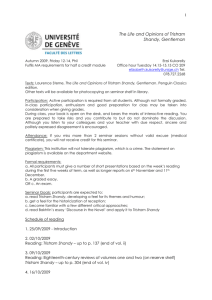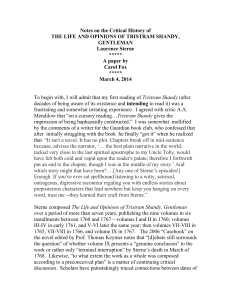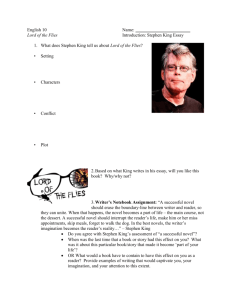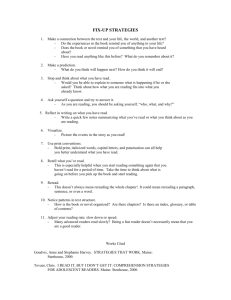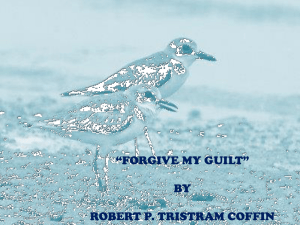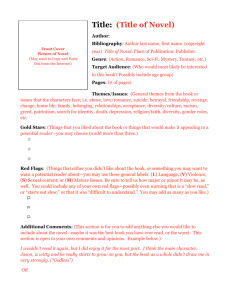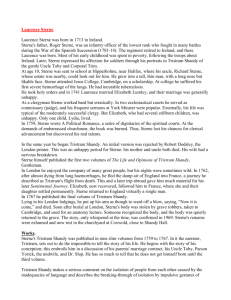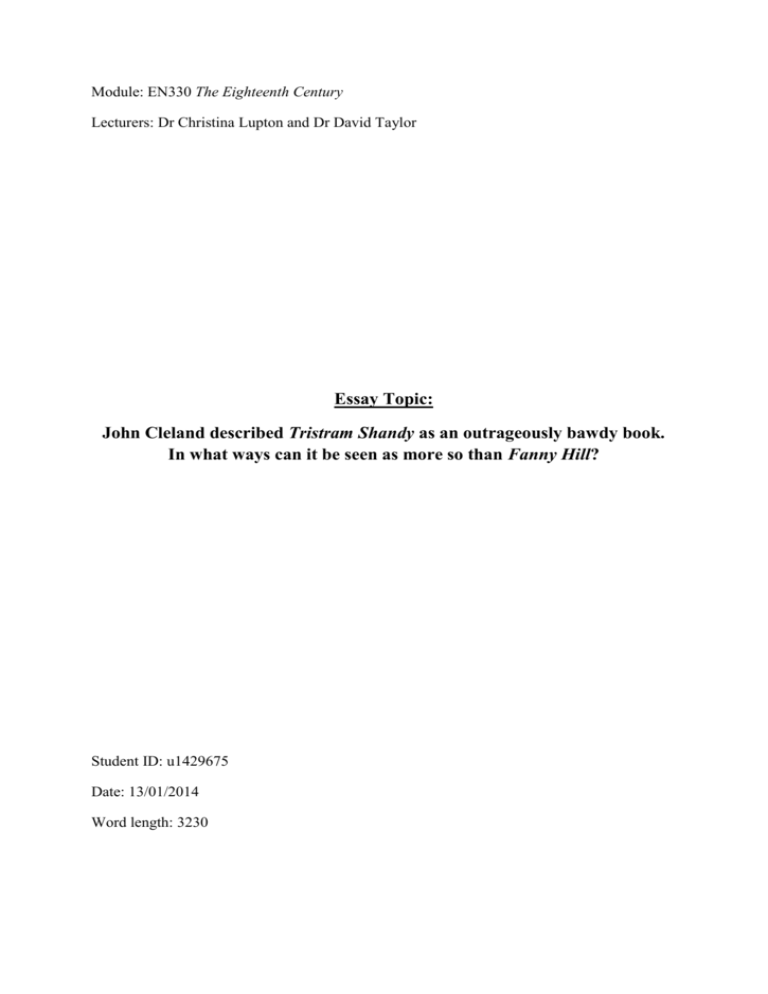
Module: EN330 The Eighteenth Century
Lecturers: Dr Christina Lupton and Dr David Taylor
Essay Topic:
John Cleland described Tristram Shandy as an outrageously bawdy book.
In what ways can it be seen as more so than Fanny Hill?
Student ID: u1429675
Date: 13/01/2014
Word length: 3230
u1429675
Considering that eighteenth-century literature witnessed the publication of an abundance of
erotic fiction, John Cleland’s description of Laurence Sterne’s novel The Life and Opinions of
Tristram Shandy, Gentleman1 as ‘outrageously bawdy’ necessarily evokes the question of
what exactly made the novel stand out from other works. The case seems even more
interesting since Cleland’s own novel Memoirs of a Woman of Pleasure2 was condemned as
“infamous” by his contemporaries and denounced by Cleland himself as “a Book I disdain to
defend, and wish, from my Soul, buried and forgot” (quoted in: Cleland, back cover).
Paradoxically, the publication history of the two novels in question conveys a very different
picture: The first edition of John Cleland’s book was published in 1748-9 and, although it can
be counted among the most frequently reprinted of all English novels, it was condemned by
readers and authorities alike so that the book has not been legally available in America until
1963 and in England until 1970 (cf. ibid. vii). John Cleland himself as well as his publisher
were arrested for the “publication of an obscene work” in 1749 (ibid. x). The publication of
the first two volumes of Tristram Shandy in 1759 was received very differently. Its author had
“hospitality and flattery lavished on him” and the publication of the following volumes was
much awaited (Sterne xiv). Against the background of these details the following essay aims
to examine in what ways Tristram Shandy can be seen as a much bawdier book than Fanny
Hill.
The analysis is going to approach the question from two different angles. The first of these
is going to focus on the primary definition of bawdy as given by the Oxford English
Dictionary as “[s]oiled, dirty, [or] filthy” (OED, n.p.). In this part, the essay is going to focus
on the role of the reader that is assumed in each of the novels and how this role contributes to
an evaluation of the novel as obscene. The second point of interest will take the definition of
bawdy as “[v]ile, [or] abominable” as a basis for the analysis (OED, n.p.). It is going to
examine the way in which the depiction of sexuality in Fanny Hill reinforces the accepted
gender relations in the eighteenth century and how Tristram Shandy subverts these and could
thus be regarded as bawdy.
At first sight, Laurence Sterne’s novel seems a lot less ‘dirty’ than Fanny Hill. Since
Cleland’s work describes the development of a young country girl into a prostitute and finally
into a woman of considerable wealth who marries her ‘true love’, sexuality is not only
pervasive throughout the novel but the major topic of it. Throughout the book, Fanny
describes her various sexual encounters and although Cleland never names male and female
1
2
In the following, the novel will be referred to as Tristram Shandy.
In the following, the novel will be referred to by its popular title Fanny Hill.
2
u1429675
sexual parts by their names and instead invents “over 50 metaphorical variations for the
penis” and almost equally as much for vagina, it is obvious what he means (Cleland xix).
Among the metaphors for penis are “affair”, “engine of love-assaults” and “formidable
machine” whereas the ones for vagina include “main spot”, “open-mouth’d gap” and “center
of all . . . senses” (ibid. 26; 40; 77; 11; 24; 25). However, what takes the edge out of the
obscenity of the content is the frequently stressed innocence with which Fanny ‘stumbles’ into
most of the “scandalous stages of . . . [her] life” (ibid. 1). The very first description Fanny
gives of herself reveals her inexperience in life:
My education, till past fourteen, was no better than very vulgar; . . . and then all my
foundation in virtue was no other than a total ignorance of vice, and the shy timidity
general to our sex, in the tender stage of life, when objects alarm, or frighten more by
their novelty, than anything else: but then this is a fear too often cured at the expense
of innocence . . . . (ibid. 2)
By this passage the reader is introduced into Fanny’s view of the world and even though they
might have a broader knowledge about life and suspect that the heroine’s innocence will
cause trouble, this potential threat is never brought up. Thus, the reader shares the innocent
world-view of Fanny and since innocence can never be bawdy, the book can in this regard not
be accused of obscenity. This point of view is maintained throughout the whole novel and
Fanny’s “little head” and “innocence” are frequently turned around and seduced by the
offerings made to her, at first by Esther Davis and then by Mrs Brown (ibid. 3; cf. ibid. 7). As
Fanny herself says: “. . . I was, no doubt, too natural, too artless . . . . (ibid. 14) The sexual
encounters Fanny engages in are constructed in the same manner. When she makes her first
sexual experiences with Phoebe at Mrs Brown’s brothel, Cleland’s heroine is surprised by the
advances that she thinks were “new . . . [and] odd” (ibid. 10). However, “imputing it to
nothing but pure kindness . . . [she] was determin’d not to be behind-hand with her, and
returned her the kiss and embrace, with all the fervor that perfect innocence knew” (ibid. 10).
Here, the reader definitely knows that Pheobe’s behavior can be classified as sexual abuse.
But again, that possibility does not occur to Fanny and is not mentioned in the novel at all.
Fanny’s following sexual encounters with men happen in very similar ways. When she meets
her beloved Charles, she is immediately struck by “prodigious love” for him and decides to be
entirely at “his disposal, let it be good or bad” (ibid. 36). Accordingly, she does not object
when he wants to sleep with her although it puts her in pain (cf. ibid. 39 ff.). Fanny’s love for
Charles in this case functions as a justification for her sleeping with him although they are not
married or have known each other for some time and the reader can, if not agree with, at least
understand her action which derives from her will to please Charles. In the following course
3
u1429675
of Cleland’s novel, Fanny’s affairs with other men are equally explained by either her
innocent stumbling into the situation as it is the case with the first encounter with Mr H or her
will to please, may it be the man or another person, such as Mrs Cole whom she wants to
thank for everything (cf. Cleland 63 ff.; 143 ff.). As can be seen, Cleland’s novel can insofar
not be accused of bawdiness as all ‘obscene situations’ occur due to the innocence of the
heroine which is assumed to be shared by the reader of the novel.
In Tristram Shandy, the case is very different. As the novel claims, the book is supposed to
narrate the life and opinions of Tristram in which case sexuality does not seem to constitute
the most important part of the novel. In the end however, although it depicts his opinions,
Sterne’s book does not reveal too much of Tristram’s life. Surprisingly, what it does is to
make sexuality and also the scatological a major theme that is present everywhere in the book
through continual innuendos. However, as Ian Watt said, the book needs a reader with a
“normally contaminated mind” in order to make the bawdy humor work (quoted in: Brady
41). This type of reader understands at least most of Sterne’s innuendos and if they do not get
some of the obscene implications of the text, it is not a big problem (cf. Brady 41). In
contrast, a completely innocent reader would miss the double entendres that are present in
almost every part of Tristram Shandy and thus most of the underlying meanings of the text
(cf. ibid. 41). But it is the narrator Tristram himself who ensures that this does not happen by
addressing the reader directly at various stages throughout the novel. One time, he
contemplates about the correct way of how to read a book and as an answer to his fictitious
reader “Madam” who missed an important implication of Tristram’s narrative he writes:
'Tis to rebuke a vicious taste which has crept into thousands besides herself, - of
reading straight forwards, more in quest of the adventures, than of the deep erudition
and knowledge which a book of this cast, if read over as it should be, would infallibly
impart with them. - The mind should be accustomed to make wise reflections, and
draw curious conclusions as it goes along . . . . (Sterne 52)
In this passage it becomes evident that readers of Tristram Shandy should not only read the
book carefully, but that they also have to draw their own conclusions on what is being
narrated. The quote thus invites the reader to actively engage in the reading process. Tristram
makes this requirement even clearer when he announces that his book is written “only . . . for
the curious and inquisitive” (ibid. 8). Keeping this announcement in mind, the frequent sexual
innuendos become more obvious. One of Sterne’s strategies of invoking sexual connotations
lies in deploying various meanings of one word. An important example for this usage is the
term “hobby-horse”. In the eighteenth century, “hobby-horse” was a slang expression for
“whore” and the underlying sexual innuendo is thus present from the beginning of the novel
4
u1429675
(cf. Brady 41). The strategy can also be seen in the following sentence where Tristram
explains his Uncle Toby’s outcry: “. . . but the true cause of his exclamation lay at least a yard
below” (Sterne 286). “Yard”, in this case, is a slang term for “penis” (cf. Harris 113).
However, if the reader does not get the double meanings, the jokes are lost so that the
effectiveness of the strategy depends on the reader’s participation.
Another strategy consists in establishing metaphorical connections between things that
normally have nothing to do with sexuality and exactly this connotation. As Elizabeth Harris
observes “almost any paragraph can make us think of sex, genitalia, male and female organs”
and “noses, whiskers, buttonholes, hobby-horses, crevices in the wall, slits in petticoats, old
cock’d hats, green petticoats . . ., even ‘things’ can have more than one meaning” (ibid. 111).
Exemplary for this strategy is the word nose which plays an important role in the novel since
Tristram’s own nose was “crush’d . . . as flat as a pancake to his face” in the process of his
birth (Sterne 193). A little later, this passage is followed by a definition of what a nose is:
“For by the word Nose, throughout all this long chapter of noses, and in every other part of
my work, where the word Nose occurs, - I declare, by that word I mean a Nose, and nothing
more, or less.” (ibid. 197) Through this specification the reader, rather than being assured that
Tristram is indeed just talking about noses, begins to think at least now about allusions that
could be made by the word. Just as the word “nose”, the word “pen” is used as a metaphor for
penis as well. This can be seen in various passages, for example in Vol. III, Ch. 28 where
Tristram “last dipp’d . . . [his] pen into . . . [his] ink” and finally “spurt[s] thy ink about thy
table and thy books” (ibid. 194). The “naive reader . . . [is thus made aware of] the principles
of the symbolism which is essential to his effort to communicate with us in Tristram Shandy”
(Anderson 972).
Additionally to being taught how to interpret double meanings correctly, the reader is also
forced into participating in the creation of the meaning of the novel. This is the case insofar as
there are various parts of the novel which are left blank and which are supposed to be
completed by the reader. Asterisks indicate either certain words which must be inferred or
whole sentences whose meaning has to be deducted from the context. Although Sterne avoids
the accusation of bawdiness through this technique, the now sufficiently ‘educated’ reader
may easily guess the sexual or scatological meanings of the passages (cf. Whittaker 28).
Besides many other examples, the following quote constitutes a sample of this technique:
“The chamber-maid had left no ****** *** under the bed: - Cannot you contrive, master,
quoth Susannah, lifting up the sash with one hand, as she spoke, and helping me up into the
window seat with the other, - cannot you manage, my dear, for a single time, to **** *** **
5
u1429675
*** ******?” (Sterne 339) As Ruth Whittaker suggests, the asterisks might substitute for the
words “chamber pot” and “piss out of the window” (35). The obscenity of Laurence Sterne’s
novel in this sense lies in the narrator forcing the reader to imagining ‘dirty’ things in order to
make sense of the novel.
In this respect, Tristram Shandy can be seen as bawdier than Cleland’s novel because it
relies on the reader’s imagination and their ability to establish connections between topics and
things that are normally unrelated to sexuality or the scatological to exactly these themes.
Hence, the effectiveness of the continual sexual innuendo relies on a complicity of the reader
with Tristram’s ‘dirty imagination’ and it is in fact an important objective of the novel to
teach the reader how to understand the bawdy humor. In Fanny Hill, in contrast, sexuality is
necessarily the main topic and it is thus obvious that descriptions of sexual encounters have to
be part of the book. However, rather than sharing in some dirty jokes the reader is complicit in
Fanny’s innocence and the novel does thus not encourage the reader to develop a sensitivity
for sexual innuendos.
As introductorily mentioned the second aspect that shall be examined is the way in which
the depiction of sexuality in Fanny Hill reinforces the accepted power structures regarding
men and women in the eighteenth century and how Tristram Shandy subverts these and could
thus be regarded as bawdy. This analysis of the two novels takes the socio-historical context
into consideration and thus relies on the second definition of the term “bawdiness” since it can
also mean “indignance” or “outrage”. As has already been mentioned above, Fanny’s life is
mostly determined by her innocence and hence, the kind of sexuality depicted in Fanny Hill
cannot be obscene. The nature of Fanny’s sexual encounters is always, as even the title of
Cleland’s work suggests, determined by pleasure. This can especially be seen in her
relationship with Charles. Although it is presented as an act of her liberty, Fanny always
subordinates to the wishes of the man (cf. Mitchell 308): “I presently drown’d all sense of
pain in the pleasure of seeing him, of thinking that I belong’d to him, he who now was the
absolute disposer of my happiness, and in one word, my fate” (Cleland 41). Her other sexual
encounters with men are presented in the same way. One of the few scenes that could be
regarded as bawdy even from the eighteenth century point of view is Fanny’s intercourse with
Mr Barvile who introduces her to sadomasochistic practices. However, even this experience
turns out to be “much more to . . . [her] satisfaction than . . . [she] had bespoke the nature of it
to turn out” when she subordinates to the will of the man (ibid. 152). The underlying strategy
is, as Margaret Mitchell argues, “intended to have a very particular effect on a specifically
male audience: Fanny Hill is, obviously, a male fantasy” (Mitchell 308). In this respect,
6
u1429675
Fanny’s innocent decisions propagate heterosexual relationships in which the woman is
subordinate to the man. The focus on ‘heterosexual’ relationships is also important since there
is one scene in the novel in which homosexuality amongst men is depicted as being something
unnatural, even immoral: “All this, so criminal a scene, I had the patience to see to an end . . .
.” (Cleland 159) The mentioned examples, along with Fanny’s reunion with her beloved
Charles at the end of the novel support the image of sexuality that could be regarded as the
accepted one in the eighteenth century.
Opposed to that, Sterne’s novel often depicts a deeply dysfunctional. The theme of
impotence pursues most of the male characters. It pursues Tristram, since the already
mentioned crushing of his nose which is a metaphor for penis leaves the reader in doubt about
his sexuality. At one point, the narrator himself makes his anxiety about his virility very clear:
- Do, my dear Jenny, tell the world for me, how I behaved under one, the most
oppressive of its kind which could befall me as a man, proud, as he ought to be, of his
manhood – ‘Tis enough, said’st thou, coming close up to me, as I stood with my
garters in my hand, reflecting upon what had not pass’d – ‘Tis enough, Tristram, and I
am satisfied, said’st thou, whispering these words in my ear, **** ** **** ***
******; - **** ** **** - any other man would have sunk down to the center –”
(Sterne 466)
Equally, Walter Shandy as well as uncle Toby are far from having normal sexual lives.
Whereas Walter is not really interested in sex and even finds the appointed time for
intercourse once a month too much, Toby’s virility is questioned because of the war wound he
has in his groin (cf. ibid. 558 f.). The ultimate questioning of virility can be found at the very
end of the last chapter of volume nine when the bull of the Shandy’s is suspected of being
impotent. This continual display of male impotence could be seen as representing a potential
threat to the gender relations of the eighteenth century since it displays the men in situations
of absolute power loss. In this respect, Tristram Shandy can be regarded as the “exact
opposite of a book like Fanny Hill, which . . . represents the new bourgeois ethics, in the
sense that it arouses male hetero-lust, tries to remove feelings of guilt about that in a
discursive manner, and idealizes sex between lovers and in marriage at the same time” (Bosch
266).
As has been shown, Tristram Shandy can be seen as bawdier than Fanny Hill in several
ways. First of all, the novel does not only heavily rely on the reader to make the sexual
innuendos work but also forces the reader to actively engage in the process of constructing the
obscene humor itself. Contrastingly, in Fanny Hill the reader shares the heroine’s point of
view and innocence and can relate the nature of her sexual encounters to her inexperience.
7
u1429675
The second way in which Tristram Shandy can be seen as bawdier than Fanny Hill is the way
in which the novel questions the gender relations of the eighteenth century. Sterne’s novel
depicts a dysfunctional male sexuality which can be seen as outrageous from an eighteenthcentury point of view insofar as it threatened to undermine the power relations between men
and women. Fanny Hill in contrast celebrates an image of sexuality that was assumed to be
the ‘correct’ one in the eighteenth century and can at least in this respect not be seen as
outrageous.
8
u1429675
Bibliography
Primary Sources
Cleland, John. Memoirs of a Woman of Pleasure. Oxford et al.: Oxford UP, 1985.
Sterne, Laurence. The Life and Opinions of Tristram Shandy, Gentleman. London et al.:
Penguin Books, 2003.
Secondary Sources
Allen, Dennis W. “Sexuality/ Textuality in Tristram Shandy.” Studies in English Literature,
1500-1900 25.3 (1985): 651-670.
Anderson, Howard. “Tristram Shandy and the Reader’s Imagination.” PMLA 86.5 (1971):
966-973.
“Bawdy.” Oxford English Dictionary. Oxford University Press. n.d.
<http://0www.oed.com.pugwash.lib.warwick.ac.uk/view/Entry/16362?rskey=ieDZRr&result=1
#eid> 10 Jan. 2015.
Bosch, René. Labyrinth of Digressions: Tristram Shandy as Perceived and Influenced by his
Early Imitators. Amsterdam and New York: Editions Rodopi B.V., 2007.
Brady, Frank. “Tristram Shandy: Sexuality, Morality, and Sensibility.” Eighteenth-Century
Studies 4.1 (1970): 41-56.
Harris, Elizabeth W. “Words, Sex, and Gender in Tristram Shandy.” The Cambridge
Companion to Laurence Sterne. Ed. Thomas Keymer. Cambridge: Cambridge UP.
111-124.
Houlihan Flynn, Carol. “What Fanny Felt: The Pains of Compliance in Memoirs of a Woman
of Pleasure.” Studies in the Novel 19.3 (1987): 284-295.
Mitchell, Margaret E. “‘Dreadful Necessities’: Nature and the Performance of Gender in
Memoirs of a Woman of Pleasure.” Women’s Studies 32.3 (2003): 305-324.
Whittaker, Ruth. Tristram Shandy. Milton Keynes: Open University Press, 1988.
9

